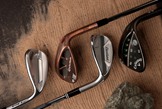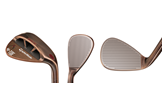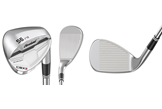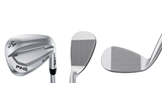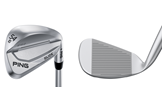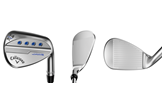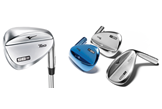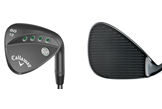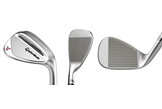Which wedge suits my game?
Published: Last updated:
Which wedge will work for you? With eight high profile new launches over the summer we put the very latest models to the test.
For decades there have been very few decisions to be made when buying new wedges. For most club golfers it has come down to choosing a brand, deciding on loft, grind and finish.
Apart from these standard choices, which essentially are cosmetic and subjective, the performance of wedges hasn’t really changed much.
But this summer there’s been a flurry of high-profile wedge launches, and some are challenging traditional wedge thinking in a way we’ve not seen before. Now there are real performance decisions for club golfers to make: Do you need a cavity back to match your irons? Would you benefit from a “high toe” shape? Do you need more help getting out of the sand?
ROBOT TESTED: Which golf ball suits my game?
All these options mean there’s never been a better time to rethink your wedge set-up. To help, we’ve tested all the new models (where lofts allowed we collected launch monitor data, too) to highlight how each compares, before coming up with some buying tips to ensure you get your perfect set-up when you next buy wedges.

Callaway Jaws MD5 – Tour Level
• RRP: £149
• Lofts: 46° / 48° / 50° / 52° / 54° / 56° / 58° / 60° / 64°
• Head options: Four sole grinds (C, s, X, W – with a new low bounce option W grind)
• Finishes: Platinum Chrome, Tour Grey
• Shaft: Dynamic Gold Tour Issue 115 (s), Project X Catalyst 80 (g)
Tech Story
New grooves are CNC milled into the face. Each groove has a 37° side wall (up from 5° in the previous MD4 model) and Callaway say the idea elevates groove sharpness to new levels. Three raised micro protrusions between each groove give 84 contact points with the ball, to create maximum spin.
Verdict
The micro-protrusions on the face of the Jaws wedges are right on the limits of the rules. Run an index finger over the face and you’ll realise how much grip they o er. For us, MD5 is much more attractively shaped than MD4. As a tour-style wedge, Jaws has a very sharp leading edge which calls for precise and accurate ball striking, especially on damp turf or sand. In the wrong hands, sharp edges increase the likelihood of digging and heavy or fat shots. Jaws is a really good-looking wedge with plenty of spin tech.

Callaway PM Grind 19 – High Toe
• RRP: £149
• Lofts: 54° / 56° / 58° / 60° / 64°
• Head options: Platinum or Tour Grey finishes
• Shaft: KBS Hi-Rev 2.0 (s)
Tech Story
Designed by short game legends Phil Mickelson and Roger Cleveland. There’s a little extra o set, micro face protrusions (to increase contact points on the ball) at 20° to the face grooves. This helps maximise spin when opening the face and a higher toe, giving more space on the face, which helps in longer grass.
Verdict
PM Grind wedges are a brilliant example of how tour-inspired clubs may not suit everyone. In the right hands PM Grinds are great; we reckon those are the types of golfers who’ll put in the time to learn how to hit different short game shots, just like Mickelson. Details like rotating the micro face protrusions to increase spin on lob shots are genius.

Cleveland CBX2 – Cavity Back
• RRP: £119
• Lofts: 46° / 48° / 50° / 52° / 54° / 56° / 58° / 60°
• Head options: N/A – But sole grinds change between lofts
• Finishes: Satin only
• Shaft: Dynamic Gold 115 (s), Rotex Precision (g)
Tech Story
Cleveland are on a mission to change the way golfers think about wedges, so o er one model aimed at tour players (RTX 4) and one for amateurs (CBX 2). More than 85 per cent of golfers use cavity back irons, so it makes perfect sense these players should try cavity back wedges, too.
Verdict
Club golfers looking at wedges should put a high priority on choosing between a blade or cavity back model. We know the extra forgiveness can shave a couple of shots a round from your game with zero trade-offs in terms of looks, feel or performance. We love how the complication of selecting sole grinds and bounce options is made for you, with less bounce where golfers need it in the lower lofts and wider, more forgiving, soles and extra bounce in the higher lofts. CBX2 produced Simon’s highest backspin numbers (52° models only, with 300rpm more than its closest rival), as the lighter shaft worked with his moderate swing speed, not against it.

Mizuno T20 – Tour Level
• RRP: £140
• Lofts: 46° / 50° / 52° / 54° / 56° / 58° / 60°
• Head options: Mid and Low bounce options (56° and 60°)
• Finishes: Mirror Chrome, Blue IP, Raw
• Shaft: Dynamic Gold Tour Issue S400 wedge
Tech Story
Progressive amounts of weight are discretely placed high in the T20’s blade, improving spin consistency and creating a tapered blade design like Mizuno’s new MP20 irons. Hydro ow micro grooves channel moisture away.
TESTED: Gapping – How to choose the right clubs for the top of your bag
Verdict
There aren’t many forged wedges nowadays, because some brands feel they get the same feel from modern casting. We wouldn’t argue with them, but if you use a set of forged irons, you’d probably want forged wedges too. And that’s where the T20s come into play. The new hydro flow grooves are barely noticeable, but only help spin consistency (this was Simon’s second highest spinning 52° wedge). We’re big fans of the classic teardrop head shape, too.
Ping Glide 3.0 – Small Cavity Back
• RRP: £130 (S) £140 (g)
• Lofts: 46° / 50° / 52° / 54° / 56° / 58° / 60°
• Head options: Thin (TS), Standard (SS) and Wide (WS) sole grinds
• Finishes: Hydropearl 2.0 only
• Shaft: Ping Z-Z115 (s), Ping Alta CB red (g)
Tech Story
A new cavity-back design expands perimeter weighting, increasing MOI, and extra mass in the toe pushes the centre of gravity higher, to deliver lower launching, higher spinning shots. 15g lighter than Ping’s typical wedges (overall weight), Glide 3.0 blends better with a set of irons.
Verdict
For golfers who can’t quite commit to a full-on cavity-back wedge just yet, the Glide 3.0 is an excellent midway alternative. Thanks to the custom tuning port (removes weight low down in the head) and extra weight high in the toe, they’re actually pretty forgiving compared to traditional blade wedges. We love how Ping have shaved weight from the head, shaft and grip; it goes some way to addressing heavy, unforgiving wedges. Our third spinniest wedge, just 350rpm down on the best, which could be different in another golfer’s hands.

TESTED: PXG’s half priced 0211 iron
Ping Glide 3.0 EYE2 – High Toe
• RRP: £130 (S) £140 (g)
• Lofts: 54° / 56°/ 58° / 60°
• Head options: Loft only
• Shaft: Ping Z-Z115 (s) Ping Alta CB red (g)
Tech Story
It’s almost 40 years since Karsten Solheim designed Ping’s rst Eye2 wedge and its high toe shape has made a comeback over recent years. Ping say the narrow hosel transition gives ultimate bunker performance and is also great for touch shots.
Verdict
There was a big difference in spin numbers between Eye2 and other high-toe models and the difference comes down to the sole set-up suiting Simon perfectly. The heavily rounded shape is an acquired taste, but the sole shaping, lighter weight and overall design perfectly fitted how Simon hits down on wedges and presents the club at impact. Eye2 generated more than 1,000rpm more spin than other high-toe models; but that won’t be the same for all, so a fitting is crucial.

TaylorMade Hi Toe Big Foot – High Toe
• RRP: £149 (S) £169 (g)
• Lofts: 58° / 60°
• Head options: Loft only
• Shaft: KBS Hi-Rev 2.0 (s), UST Mamiya Recoil (g)
Tech Story
TaylorMade developed the original Hi-Toe with Justin Rose, but today you’ll nd them in lots of top players’ bags. The thinking is pretty simple – a 5mm higher toe pulls the centre of gravity up the face, which gives a lower launch and extra spin. The Big Foot has a 32mm wide sole (bigger than most) and 15° bounce, along with an anti-dig leading edge which enhances playability from sand/rough.
TESTED: Should I use a low spin driver?
Verdict
If the Bigfoot had been launched five years ago it would have been laughed at. But in today’s varied wedge market it’s a completely legitimate option and particularly good for golfers who struggle from sand. The big benefit is how the leading edge is actually pretty straight and while we struggle to get our head around full face grooves there’s no doubt they increase spin from certain situations. For golfers who struggle from bunkers Bigfoot could be a Godsend; for anyone else, high-toe-style wedges should be a serious consideration as the most lofted wedge in your bag.

TaylorMade Milled Grind 2 – Tour Level
• RRP: £149
• Lofts: 48° / 50° / 52° / 54° / 56° / 58° / 60°
• Head options: Low and Standard bounce
• Finishes: Satin Chrome, Matte Black
• Shaft: Dynamic Gold S200
Tech Story
TaylorMade say 90 per cent of their tour pros use raw (unplated or finished) wedges. And they do so because they spin more, as plated finishes cover the edges of sharp grooves, naturally dulling them. But trying to convince consumers to buy raw wedges which rust is really difficult. So TaylorMade have come up with a new Raw face design, so only the face rusts. Clever.
Verdict
By coming up with the idea to only let the faces rust, club golfers get extra spin in a wedge that still looks great. We only hit the MG 2 in a 50° loft so it’s unfair to compare it to 52° models, but we do believe that for golfers who love straighter leading edge wedges (especially in lower lofts) and narrow tour soles, MG 2 is a brilliant option. Beautifully simple, but full of spin tech.
Five things to remember when you’re next in the pro shop looking at new wedges…
• #1 Can I Accept Cavity-Back Wedges?
If you use cavity back irons you should certainly at least think about using cavity back wedges, too. It’s the first question anyone looking at new wedges should now be asking. Cleveland say it can improve your approach accuracy by three to four yards; now that doesn’t sound much, but a difference of nine to 12 feet really can mean the difference between hanging on to the edge of the green or tumbling off it, which for many club golfers means making bogey or worse.
• #2 Can I Accept a High-Toe Model?
High-Toe wedges (TaylorMade Hi-Toe Bigfoot, Callaway PM Grind 2019 and Ping Glide 3.0 Eye2 are all high-toe models in this test) give a very different appearance to traditionally shaped wedges. If you can stomach high-toe models (or any model which is significantly thicker higher in the blade), they help with shot to shot spin consistency, lower your trajectory a little and add spin. We like the idea of high-toe-style wedges as the highest lofted wedge in a golfer’s bag.
• #3 Can I Accept Full Face Grooves?
Like high-toe wedges full face grooves can be an acquired taste, as they look very different to traditional wedges. If you’re happy to use full face groove models (on Callaway’s PM Grind 2019 and TaylorMade Hi-Toe Bigfoot in this test) you’re maximising your chances of generating spin, no matter where shots impact the face. The tech only really comes into play from sand or long grass when playing explosion shots, but we reckon they’re a great idea on your highest lofted wedge.
• #4 Give Serious Thought To Shafts
A top tour rep told us recently how some of the biggest stars on tour insist their wedge shafts are a ex weaker than their irons. The reasoning is top players very rarely hit full-out shots with their wedges, so a slightly softer flex gives the same feel as a stiffer shaft hit at-out in their irons. In a perfect world, you’d get fitted for new wedges and use a similar weight and flex shaft to your irons. It avoids a gap in weight between irons and wedges, which leads to inconsistencies.
• #5 Struggle From Sand?
Grab a BigFoot. There’s no shame in finding it difficult to get out of bunkers – tons of club golfers do. If you have difficulty escaping sand at the first attempt, clubs like TaylorMade’s new Bigfoot wedge can really help. If you have room in your bag, consider a single wedge for bunker play. And we’d suggest if you struggle from sand look at wide sole, high bounce models, which help stop the club digging too deep and get you out consistently at the first attempt. … when you’re next in the pro shop looking at new wedges

